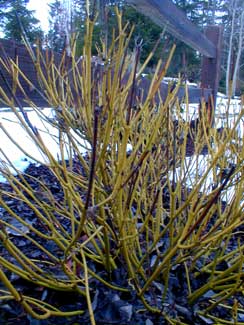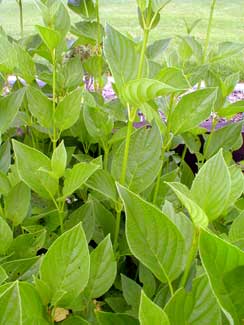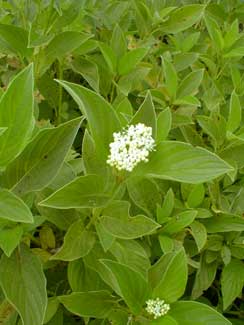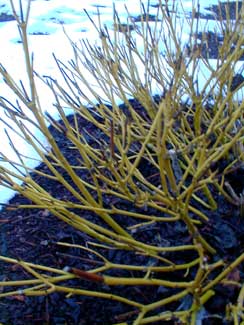
'Flaviramea' Yellowtwig Dogwood
"The fields gleam mildly back upon the sky,
And far & near upon the leafless shrubs
The snow dust still emits a silver light."
-Henry David Thoreau
(1817-1862)
(1817-1862)
Dogwoods fall into two categories judged by their flowers: the "red line" dogwoods have large showy bracts surrounding miniscule true flowers, these being the most commonly grown dogwood trees, but also the little bunchberries groundcover. The other category comprise "blue line" dogwoods which have no bracts, but only the teenciest true flowers. The Yellowtwig & the Redtwig dogwoods are of this latter group.
The wee flowers are sufficiently numerous in each cluster to be showy, even if less amazing than red line dogwoods with their large petal-like bracts.
 The Yellowtwig (or as two words Yellow Twig) or Gold Twig dogwood cultivar Cornus sericea 'Flaviramea' has its best winter-limb color when planted in full sun. Shrubs that are pruned annually or every second year have much more deeply colored twigs for winter display, but shrubs not so often pruned flower & fruit far better since this is done mainly on the older limbs.
The Yellowtwig (or as two words Yellow Twig) or Gold Twig dogwood cultivar Cornus sericea 'Flaviramea' has its best winter-limb color when planted in full sun. Shrubs that are pruned annually or every second year have much more deeply colored twigs for winter display, but shrubs not so often pruned flower & fruit far better since this is done mainly on the older limbs.It is always a balancing act to have the best of all categories. Pruning between one-fourth & one-third of the shrub each year, usually at winter's end or early spring, insures that the young brightest colored twigs are numerous. Leaving a mature two-thirds allows for blooms on the older wood.
Some gardeners forgo most of the flowers in some years in favor of hard-pruning every third year, so that all the limbs on this dogwoods will be young & brightly colored, & so that the whole shrub will be of semi-dwarf stature. Mature upright limbs will reach five or six feet on 'Flaviramea' & be as big around as the thumb, but first-year limbs can average three to four feet tall & big around as the pinky.
 The only reason pruning is required is for the sake of the twig color; it will be just as healthy, though far less yellow-twigged, if never pruned. So it is just as suitable as a fruit-baring bird-attracting shrub requiring no pruning or other mainteance.
The only reason pruning is required is for the sake of the twig color; it will be just as healthy, though far less yellow-twigged, if never pruned. So it is just as suitable as a fruit-baring bird-attracting shrub requiring no pruning or other mainteance.The species is extremely varied over its extensive range throughout North America. The most significant distinction is between two types of limb colors: The Redtwig , & the one shown here, the Yellowtwig. They're the same species despite their startling contrasts, the more striking after snowfall when the shiny upright twigs are bright yellow or bright red against fresh fallen snow.
There are several of this shrub throughout a friend's landscape which I help maintain. These were inherited when the house was purchased. The top photo shows one against snowfall in January. The second photo snapped in June shows another specimen in full leaf. The third photo shows a late reflowering in August.
Though wild specimens can reach ten feet, the cultivated 'Flaviramea' tends to remain in the range of five or six feet tall & five feet wide, though it can get bigger if never pruned. Very young plants will be two or three feet their first few years.
 With proper cross-pollinization when planted in groups, spring flowers will turn into impressive berries, snowy white on some specimens, but sometimes bluish steel-grey.
With proper cross-pollinization when planted in groups, spring flowers will turn into impressive berries, snowy white on some specimens, but sometimes bluish steel-grey.When planted singly, flowers will not readily turn into fruits. If not gotten by birds these can linger on the shrub until well into autumn.
The berries are not widely regarded as edible, though songbirds, grouse, quail, ducks, squirrels, mice, deer, elk, & black bears like them, then poop out the seeds for further dispersal of the species.
The seeds do not germinate well if they have not passed through an animal's digestive tract, but seeds that have not been thus "passed" are easily stored for up to eight years, then can be induced to germinate by scarification & cold stratification four to twelve weeks. It is easiest to propogate via rooted cuttings or by slicing/spading off some of the root with young limbs or shoots.
Despite that its berries aren't much harvested for human use, being bitter raw, & very mildly toxic so that eating a great many raw could cause stomach upset, Native Americans nevertheless mixed it with better-tasting fruits & found it pallatable enough in dried pounded cakes or preserved in bear fat.
If cooked, sieved, & sweeteened, the processing breaks down the mild toxin, so that it's entirely safe to make a good jelly.
The seeds are additionally a source of oil. Native peoples made tooth-cleaning twigs from this dogwood to help fight gum disease. A concoction from the bark & roots was used as an herbal remedy internally for colds & externally for rashes. This concoction was allegedly mildly intoxicating when taken internally. Its efficacy for any medical purpose has not been well investigated & it is not in the modern age much used by herbalists.
The species has gone through many taxonomic changes, & was formerly known as C. stolonifera, or as a North American variant of the European C. alba. It's gone by several other names over time, but these two still often occur on labeling that to be up-to-date should state C. sericea, from a Greek word implying silkiness.
These shrubs have also gone by several common names other than Yellowtwig & Redtwig, including such regional names as Squawbush, Shoemack, Waxberry, Cornel, Western Dogberry, Osier, & even occasionally Kinnickinnik (Indian Tobacco) because the inner bark was dried for use as a tobacco substitute. This latter name is more often reserved nowadays for the groundcover evergreen shrub Arctostaphylos uva-ursi.
It is radically cold-hardy (to zone 3), & drought-hardy if not too dry for too long at a time, & very tolerant of periodic sogginess. It tolerates all sorts of soils, but prefers loamy acidic moist well-draining soil. It will do nicely to reinforce steep banks over run-off ditches or natural streams.